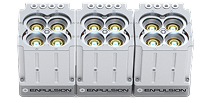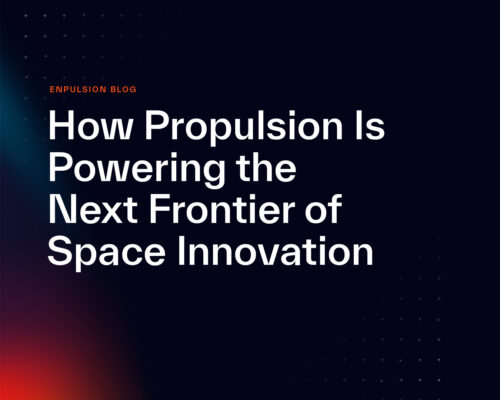Choosing a Propulsion System: What to Consider for Your Satellite Mission
Designing a satellite means making countless decisions, but propulsion stands apart as the system that can define the mission itself. The thruster you choose does more than just move your spacecraft — it shapes its trajectory, governs how long it can operate, and determines the range of mission objectives it can achieve.
Legacy electric propulsion systems tend to force spacecraft engineers and designers into difficult choices. While conventional designs can address some SmallSat requirements, they typically do so at the expense of agility, efficiency, or mission longevity.
- Gridded ion thrusters: Highly efficient, but require significant power and generate high thermal loads.
- Hall effect thrusters: Robust and well-understood, but bulky and difficult to scale down for small platforms.
- Colloid thrusters: Offer precision control, but can be less scalable and harder to integrate.
At Enpulsion, we eliminate many of the propulsion trade-offs smallsat teams typically face. Our modular FEEP propulsion systems combine low power consumption, high specific impulse, compact form factors, and simplified integration — offering more design flexibility and fewer compromises across CubeSat and ESPA-class smallsat missions.
How to choose a satellite thruster
When choosing a propulsion system, there are five variables every satellite team should evaluate. We’ll break those down and explain how our systems overcome some of the biggest challenges.
1. Mission objectives and constraints
The first question you should be asking is also the most important: What do you need your propulsion system to do? The specifics of your mission can dictate a wide range of propulsion needs.
- Performing station-keeping in low-earth orbit? You’ll want to prioritize efficiency and precise thrust at low duty cycles.
- Need constellation phasing or responsive maneuvering? Flexibility and rapid delta-V are essential.
- Deploying a sensitive payload? You’ll likely consider a low-vibe, low-outgassing system to minimize instrument interference.
Solar panels, antennas, sensors, or other onboard equipment should also be accounted for at this planning stage. These components will influence payload capacity and the available volume for propulsion mounting, thermal interfaces, and line-of-sight clearance.
Thanks to the versatility of modular FEEP architecture, Enpulsion propulsion systems can support a broad performance envelope without custom development. Because each unit is contained in a stackable module, and each emitter tip can be turned on or off to fine-tune thrust, our systems can be tailored to fit the mission — flexing between ultra-low thrust with fine control, to rapid maneuvers.
2. Power allocation
Once you have a clear understanding of your mission objectives, power considerations should come next. Tight constraints can make these especially challenging, especially for small satellites. Systems like gridded ion and Hall effect typically require hundreds of watts, levels that are out of reach for most smaller units, which often rely on much lower power ranges. Allocating hundreds of watts to propulsion would severely limit power available for communications, payloads, and onboard computing.
There are two primary reasons Enpulsion systems are ideal for low power constraints:
- They operate efficiently at low power levels, with some models running at 30 W nominal. Since they allow propulsion to operate without stealing margin from other systems, they’re ideal for missions like formation flying, drag compensation in low Earth orbit, or deep-space operations far from the sun.
- They don’t need power-hungry pumps or complex fluidic systems and can minimize thermal overhead. This allows for simpler power integration, which means fewer compromises on other power needs.
3. Mass and volume constraints
The thrusters on your satellite will directly impact the total payload capacity. Your mission objectives should already give you an idea of additional equipment you’ll be adding to the system — a heavy system with tanks and valves could force a structural redesign or shorten a mission’s lifespan because it will need more fuel.
Enpulsion propulsion systems are compact and fully contained in the unit housing, saving both mass and footprint. We also use a solid indium fuel source — a dense, non-pressurized metal that simplifies fueling and avoids the added bulk of pressurized tanks or feed systems. As a result, you gain more mass margin to your payload and more flexibility in your design layout.
4. Timeline for integration and testing
The more complex a propulsion system, the more potential delays in your development cycle. Systems with pressurized tanks or volatile chemicals can increase safety protocols, testing requirements, special software, or other complications that can add weeks — or months — to timelines.
Plug-and-play simplicity is one of the main advantages of Enpulsion propulsion systems. Again, since the entire thruster is contained in one module, it connects to the rest of the system with one simple cable. Each system is also pre-loaded with solid fuel, so no specialized launch procedures are needed. Standard software is easy to integrate with other systems.
Lastly, our production process follows the Kanban production system and standardized acceptance testing. Each component is fully traceable, and each unit is built faster — the best of both worlds, especially for procurement departments.
5. Heritage and reliability
Propulsion is a mission-critical system — and reliability is non-negotiable. That’s why flight heritage matters.
Enpulsion thrusters have logged extensive in-orbit experience across a broad spectrum of missions and orbital regimes. With more than 280 flight-proven units in orbit, our systems have consistently delivered stable, dependable performance in some of the most demanding conditions space has to offer.
Select your satellite propulsion with confidence
Focusing on mission-specific needs will help you confidently build a propulsion strategy that supports your goals and simplifies your design. Understanding the full scope of the mission profile, power requirements, mass, timeline, and reliability will help you ask the right questions and identify the appropriate system.
Whether you're finalizing your design or still weighing options, our satellite propulsion experts can help you find the right balance between capability, complexity, and cost — so your team can move fast and launch smart. Connect with us today!
Get the latest information on Enpulsion innovation.
Subscribe to stay up to date on Enpulsion news, technology updates, and industry events.





